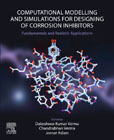
Computational Modelling and Simulations for Designing of Corrosion Inhibitors: Fundamentals and Realistic Applications
Verma, Dakeshwar Kumar
Verma, Chandrabhan
Aslam, Jeenat
Computational Modeling and Simulations for Designing of Corrosion Inhibitors: Fundamentals and Realistic Applications offers a collection of major advancements in the field of computational modeling for the design and testing of corrosion inhibition effectiveness of organic corrosion inhibitors. This guide presents the latest developments in molecular modeling of organic compounds using computational software, which has emerged as a powerful approach for theoretical determination of corrosion inhibition potentials of organic compounds. The book covers common techniques involved in theoretical studies of corrosion inhibition potentials, and mechanisms such as density functional theory, molecular dynamics, Monte Carlo simulations, artificial neural networks, and quantitative structure-activity relationship. Covers basic, fundamental principles, advantages, parameters, and applications of computational and molecular modeling for designing potential corrosion inhibitors for metals and alloys Describes advancements of computational modeling for the design of organic corrosion inhibitors and applications in electrochemical engineering and materials science Focuses on the most advanced applications in industry-oriented fields, including current challenges Includes websites of interest and information about the latest research INDICE: Part 1. Fundamental and Basics of corrosion mechanism 1. Corrosion Inhibition: Current trends and challenges 2. Theory of Corrosion and Corrosion Inhibition 3. Organic corrosion inhibitors 4. Deep understanding of corrosion inhibition mechanism based on first-principle calculations 5. Molecular modelling in corrosion inhibition assessments Part 2. Molecular modelling of corrosion inhibition: Advantages and challenges 6. DFT based molecular modelling 7. MD based computational modelling 8. MC simulation based molecular modelling 9. QSAR and Artificial neural network (ANN) based molecular modelling 10. MEPTIC and Machine Learning Approaches of corrosion inhibition 11. Explicit Modelling of Corrosion Inhibition Part 3. Basic parameters derived from computational modelling 12. Electrochemical principles of corrosion inhibition: fundamental and computational aspects of DFT 13. DFT-based chemical reactivity concepts, calculations, and their application to designing green corrosion inhibitors 14. Theories and radial distribution function of MD and MC simulations 15. Important parameters derived from MC and MD simulations 16. Theories, methods and the parameters of QSAR and ANN Part 4. Theoretical insight in designing green corrosion inhibitors 17. Theoretical calculations-based results for plan extract as green corrosion inhibitors 18. Aliphatic organic compounds as corrosion inhibitors for ferrous and nonferrous metals 19. Nitrogen containing heterocyclic compounds as green corrosion inhibitors 20. Oxygen containing heterocyclic compounds as green corrosion inhibitors 21. Phosphorus containing molecules as green corrosion inhibitors 22. Sulphur containing heterocyclic compounds as green corrosion inhibitors 23. Carbohydrates and derivatives as green corrosion inhibitors 24. Pharmaceutical drugs as prominent corrosion inhibitors 25. Ionic liquids as green corrosion inhibitors 26. QSAR and ANN based results for designing corrosion inhibitors
- ISBN: 978-0-323-95161-6
- Editorial: Elsevier
- Encuadernacion: Rústica
- Páginas: 300
- Fecha Publicación: 01/01/2023
- Nº Volúmenes: 1
- Idioma: Inglés
